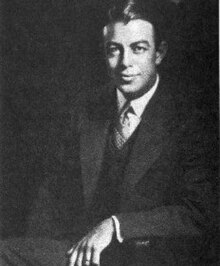
Back بنيامين لي وورف Arabic بنيامين لى وورف ARZ بنجامین لی وورف AZB Бенджамін Лі Уорф Byelorussian Бенджамин Уорф Bulgarian বেনজামিন হোর্ফ Bengali/Bangla Benjamin Lee Whorf Catalan Benjamin Lee Whorf Czech Benjamin Lee Whorf Danish Benjamin Lee Whorf German
Benjamin Lee Whorf | |
|---|---|
 | |
| Born | April 24, 1897 Winthrop, Massachusetts, U.S. |
| Died | July 26, 1941 (aged 44) Hartford, Connecticut, U.S. |
| Alma mater | Massachusetts Institute of Technology |
| Known for | Sapir–Whorf hypothesis (Linguistic relativity), Nahuatl linguistics, allophone, cryptotype, Maya script |
| Spouse |
Celia Inez Peckham (m. 1920) |
| Children | 3 |
| Relatives | Mike Whorf (nephew) |
| Scientific career | |
| Fields | linguistics, anthropology, fire prevention |
| Institutions | Hartford Fire Insurance Company, Yale University |
Benjamin Lee Whorf (/hwɔːrf/; April 24, 1897 – July 26, 1941) was an American linguist and fire prevention engineer[1] best known for proposing the Sapir–Whorf hypothesis. He believed that the structures of different languages shape how their speakers perceive and conceptualize the world. Whorf saw this idea, named after him and his mentor Edward Sapir, as having implications similar to those of Einstein's principle of physical relativity.[2] However, the concept originated from 19th-century philosophy and thinkers like Wilhelm von Humboldt[3] and Wilhelm Wundt.[4]
Whorf initially pursued chemical engineering but developed an interest in linguistics, particularly Biblical Hebrew and indigenous Mesoamerican languages. His groundbreaking work on the Nahuatl language earned him recognition, and he received a grant to study it further in Mexico. He presented influential papers on Nahuatl upon his return. Whorf later studied linguistics with Edward Sapir at Yale University while working as a fire prevention engineer.
During his time at Yale, Whorf worked on describing the Hopi language and made notable claims about its perception of time. He also conducted research on the Uto-Aztecan languages, publishing influential papers. In 1938, he substituted for Sapir, teaching a seminar on American Indian linguistics. Whorf's contributions extended beyond linguistic relativity; he wrote a grammar sketch of Hopi, studied Nahuatl dialects, proposed a deciphering of Maya hieroglyphic writing, and contributed to Uto-Aztecan reconstruction.
After Whorf's premature death from cancer in 1941, his colleagues curated his manuscripts and promoted his ideas regarding language, culture, and cognition. However, in the 1960s, his views fell out of favor due to criticisms claiming his ideas were untestable and poorly formulated. In recent decades, interest in Whorf's work has resurged, with scholars reevaluating his ideas and engaging in a more in-depth understanding of his theories. The field of linguistic relativity remains an active area of research in psycholinguistics and linguistic anthropology, generating ongoing debates between relativism and universalism. Whorf's contributions to linguistics, such as the allophone and the cryptotype, have been widely accepted.
- ^ Newcombe & Uttal (2006); Chapman & Routledge (2005:268–71)
- ^ Heynick (1983)
- ^ Kahane, Henry; Kahane, Renée (1983). "Humanistic linguistics". The Journal of Aesthetic Education. 17 (4): 65–89. doi:10.2307/3332265. JSTOR 3332265.
- ^ Klautke, Egbert (2010). "The Mind of the Nation: The Debate about Völkerpsychologie, 1851–1900" (PDF). Central Europe. 8 (1): 1–19. doi:10.1179/174582110X12676382921428. S2CID 14786272. Retrieved July 8, 2020.